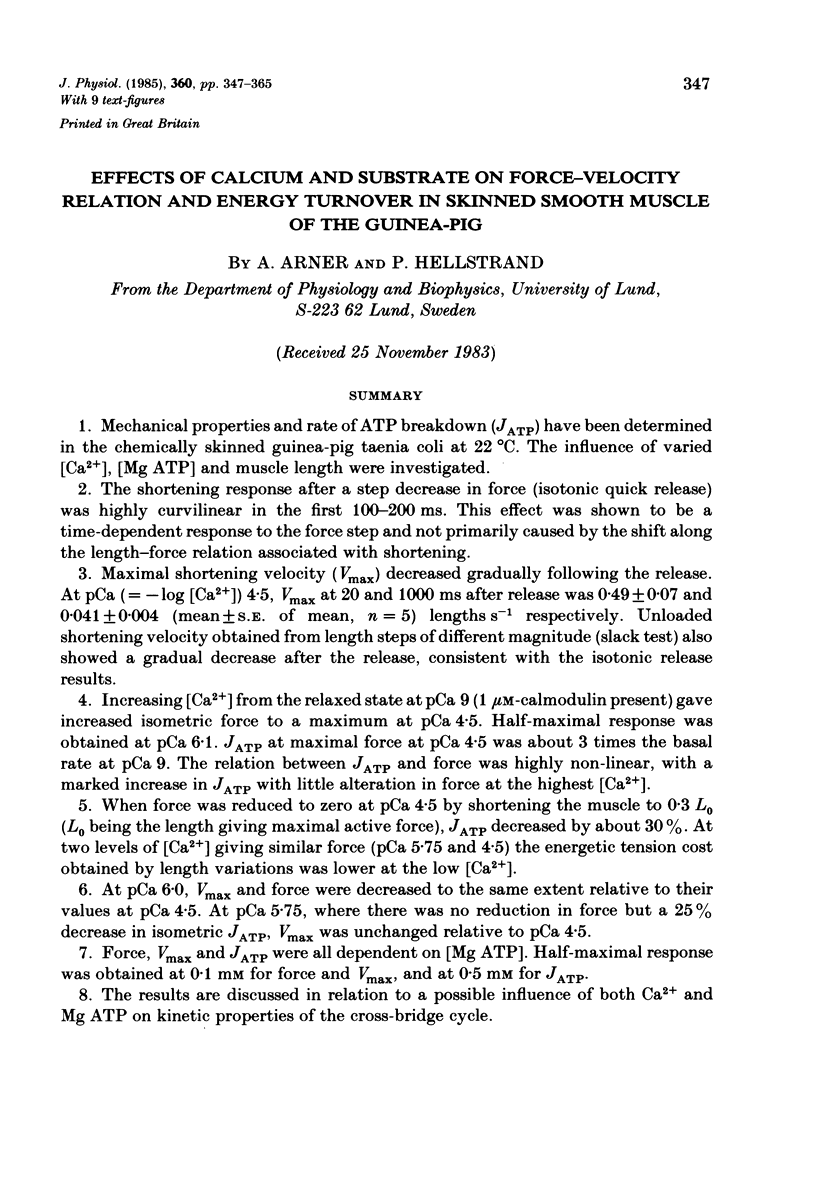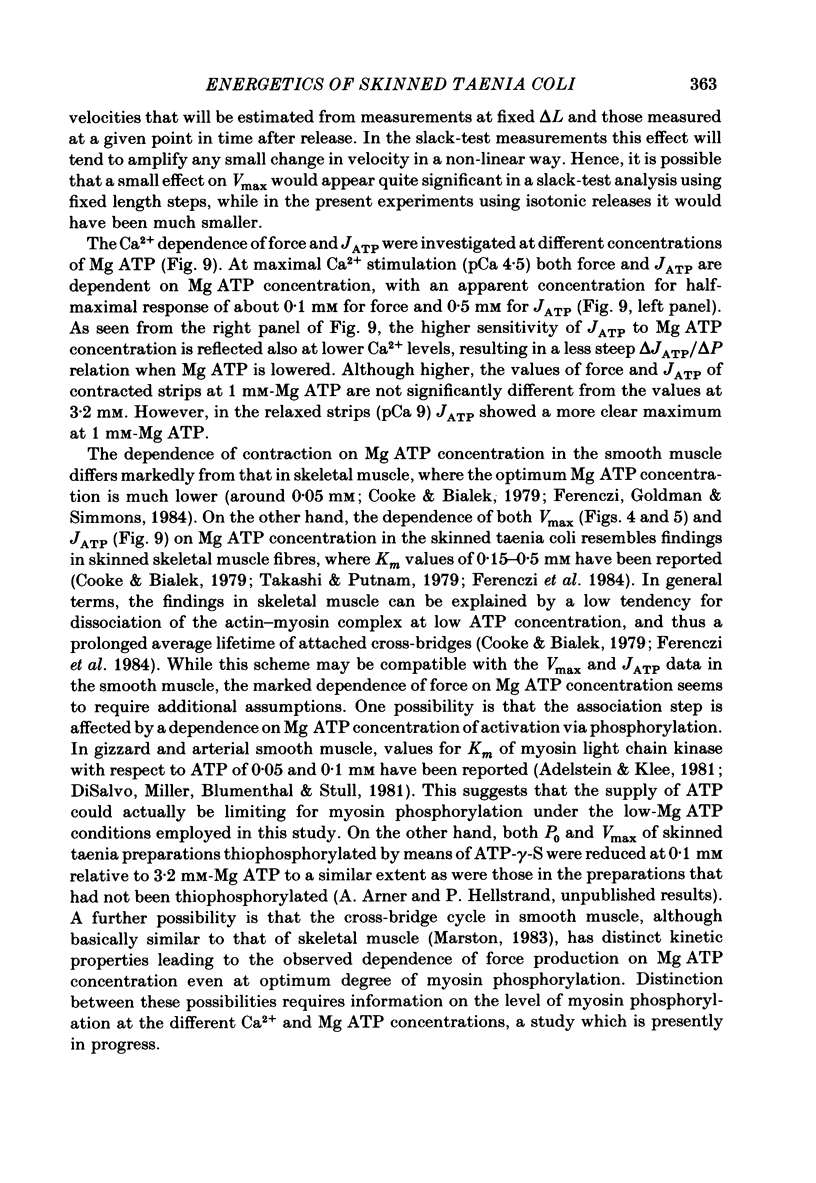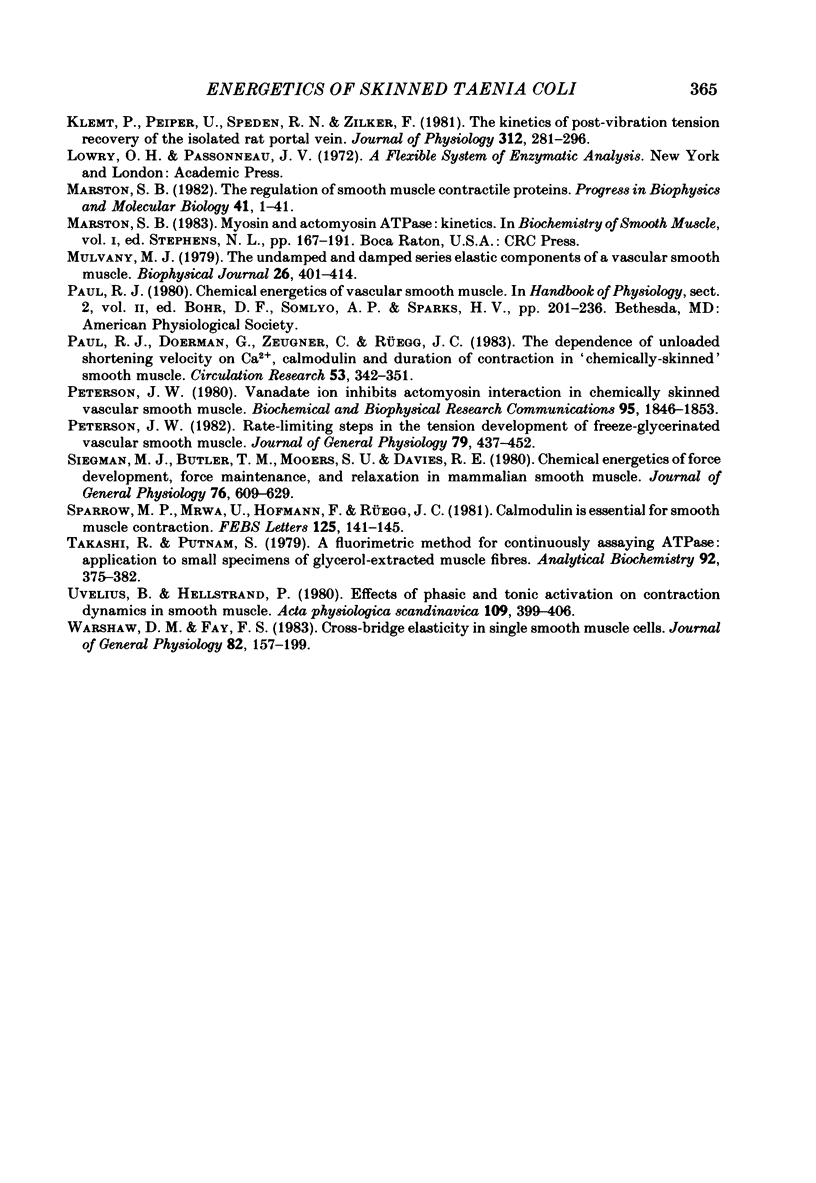Abstract
Mechanical properties and rate of ATP breakdown (JATP) have been determined in the chemically skinned guinea-pig taenia coli at 22 degrees C. The influence of varied [Ca2+], [Mg ATP] and muscle length were investigated. The shortening response after a step decrease in force (isotonic quick release) was highly curvilinear in the first 100-200 ms. This effect was shown to be a time-dependent response to the force step and not primarily caused by the shift along the length-force relation associated with shortening. Maximal shortening velocity (Vmax) decreased gradually following the release. At pCa (= -log [Ca2+]) 4.5, Vmax at 20 and 1000 ms after release was 0.49 +/- 0.07 and 0.041 +/- 0.004 (mean +/- S.E. of mean, n = 5) lengths s-1 respectively. Unloaded shortening velocity obtained from length steps of different magnitude (slack test) also showed a gradual decrease after the release, consistent with the isotonic release results. Increasing [Ca2+] from the relaxed state at pCa 9 (1 microM-calmodulin present) gave increased isometric force to a maximum at pCa 4.5. Half-maximal response was obtained at pCa 6.1. JATP at maximal force at pCa 4.5 was about 3 times the basal rate at pCa 9. The relation between JATP and force was highly non-linear, with a marked increase in JATP with little alteration in force at the highest [Ca2+]. When force was reduced to zero at pCa 4.5 by shortening the muscle to 0.3 L0 (L0 being the length giving maximal active force), JATP decreased by about 30%. At two levels of [Ca2+] giving similar force (pCa 5.75 and 4.5) the energetic tension cost obtained by length variations was lower at the low [Ca2+]. At pCa 6.0, Vmax and force were decreased to the same extent relative to their values at pCa 4.5. At pCa 5.75, where there was no reduction in force but a 25% decrease in isometric JATP, Vmax was unchanged relative to pCa 4.5. Force, Vmax and JATP were all dependent on [Mg ATP]. Half-maximal response was obtained at 0.1 mM for force and Vmax, and at 0.5 mM for JATP. The results are discussed in relation to a possible influence of both Ca2+ and Mg ATP on kinetic properties of the cross-bridge cycle.
Full text
PDF


















Selected References
These references are in PubMed. This may not be the complete list of references from this article.
- Adelstein R. S., Klee C. B. Purification and characterization of smooth muscle myosin light chain kinase. J Biol Chem. 1981 Jul 25;256(14):7501–7509. [PubMed] [Google Scholar]
- Arner A. Force-velocity relation in chemically skinned rat portal vein. Effects of Ca2+ and Mg2+. Pflugers Arch. 1983 Apr;397(1):6–12. doi: 10.1007/BF00585160. [DOI] [PubMed] [Google Scholar]
- Arner A., Hellstrand P. Activation of contraction and ATPase activity in intact and chemically skinned smooth muscle of rat portal vein. Dependence on Ca++ and muscle length. Circ Res. 1983 Nov;53(5):695–702. doi: 10.1161/01.res.53.5.695. [DOI] [PubMed] [Google Scholar]
- Arner A. Mechanical characteristics of chemically skinned guinea-pig taenia coli. Pflugers Arch. 1982 Dec;395(4):277–284. doi: 10.1007/BF00580790. [DOI] [PubMed] [Google Scholar]
- Cooke R., Bialek W. Contraction of glycerinated muscle fibers as a function of the ATP concentration. Biophys J. 1979 Nov;28(2):241–258. doi: 10.1016/S0006-3495(79)85174-7. [DOI] [PMC free article] [PubMed] [Google Scholar]
- Dillon P. F., Aksoy M. O., Driska S. P., Murphy R. A. Myosin phosphorylation and the cross-bridge cycle in arterial smooth muscle. Science. 1981 Jan 30;211(4481):495–497. doi: 10.1126/science.6893872. [DOI] [PubMed] [Google Scholar]
- Edman K. A. The velocity of unloaded shortening and its relation to sarcomere length and isometric force in vertebrate muscle fibres. J Physiol. 1979 Jun;291:143–159. doi: 10.1113/jphysiol.1979.sp012804. [DOI] [PMC free article] [PubMed] [Google Scholar]
- Fabiato A., Fabiato F. Calculator programs for computing the composition of the solutions containing multiple metals and ligands used for experiments in skinned muscle cells. J Physiol (Paris) 1979;75(5):463–505. [PubMed] [Google Scholar]
- Fabiato A. Myoplasmic free calcium concentration reached during the twitch of an intact isolated cardiac cell and during calcium-induced release of calcium from the sarcoplasmic reticulum of a skinned cardiac cell from the adult rat or rabbit ventricle. J Gen Physiol. 1981 Nov;78(5):457–497. doi: 10.1085/jgp.78.5.457. [DOI] [PMC free article] [PubMed] [Google Scholar]
- Ferenczi M. A., Goldman Y. E., Simmons R. M. The dependence of force and shortening velocity on substrate concentration in skinned muscle fibres from Rana temporaria. J Physiol. 1984 May;350:519–543. doi: 10.1113/jphysiol.1984.sp015216. [DOI] [PMC free article] [PubMed] [Google Scholar]
- Gordon A. R. Contraction of detergent-treated smooth muscle. Proc Natl Acad Sci U S A. 1978 Jul;75(7):3527–3530. doi: 10.1073/pnas.75.7.3527. [DOI] [PMC free article] [PubMed] [Google Scholar]
- Güth K., Junge J. Low Ca2+ impedes cross-bridge detachment in chemically skinned Taenia coli. Nature. 1982 Dec 23;300(5894):775–776. doi: 10.1038/300775a0. [DOI] [PubMed] [Google Scholar]
- Hellstrand P., Johansson B. Analysis of the length response to a force step in smooth muscle from rabbit urinary bladder. Acta Physiol Scand. 1979 Jun;106(2):221–238. doi: 10.1111/j.1748-1716.1979.tb06392.x. [DOI] [PubMed] [Google Scholar]
- Hellstrand P., Johansson B. The force-velocity relation in phasic contractions of venous smooth muscle. Acta Physiol Scand. 1975 Feb;93(2):157–166. doi: 10.1111/j.1748-1716.1975.tb05804.x. [DOI] [PubMed] [Google Scholar]
- Hellstrand P., Paul R. J. Phosphagen content, breakdown during contraction, and O2 consumption in rat portal vein. Am J Physiol. 1983 Mar;244(3):C250–C258. doi: 10.1152/ajpcell.1983.244.3.C250. [DOI] [PubMed] [Google Scholar]
- Huxley A. F. Muscular contraction. J Physiol. 1974 Nov;243(1):1–43. [PMC free article] [PubMed] [Google Scholar]
- Johansson B., Hellstrand P., Uvelius B. Responses of smooth muscle to quick load change studied at high time resolution. Blood Vessels. 1978;15(1-3):65–82. doi: 10.1159/000158154. [DOI] [PubMed] [Google Scholar]
- Klemt P., Peiper U., Speden R. N., Zilker F. The kinetics of post-vibration tension recovery of the isolated rat portal vein. J Physiol. 1981 Mar;312:281–296. doi: 10.1113/jphysiol.1981.sp013629. [DOI] [PMC free article] [PubMed] [Google Scholar]
- Marston S. B. The regulation of smooth muscle contractile proteins. Prog Biophys Mol Biol. 1983;41(1):1–41. doi: 10.1016/0079-6107(83)90024-x. [DOI] [PubMed] [Google Scholar]
- Mulvany M. J. The undamped and damped series elastic components of a vascular smooth muscle. Biophys J. 1979 Jun;26(3):401–413. doi: 10.1016/S0006-3495(79)85261-3. [DOI] [PMC free article] [PubMed] [Google Scholar]
- Paul R. J., Doerman G., Zeugner C., Rüegg J. C. The dependence of unloaded shortening velocity on Ca++, calmodulin, and duration of contraction in "chemically skinned" smooth muscle. Circ Res. 1983 Sep;53(3):342–351. doi: 10.1161/01.res.53.3.342. [DOI] [PubMed] [Google Scholar]
- Peterson J. W., 3rd Rate-limiting steps in the tension development of freeze-glycerinated vascular smooth muscle. J Gen Physiol. 1982 Mar;79(3):437–452. doi: 10.1085/jgp.79.3.437. [DOI] [PMC free article] [PubMed] [Google Scholar]
- Peterson J. W. Vanadate ion inhibits actomyosin interaction in chemically skinned vascular smooth muscle. Biochem Biophys Res Commun. 1980 Aug 29;95(4):1846–1853. doi: 10.1016/s0006-291x(80)80114-8. [DOI] [PubMed] [Google Scholar]
- Siegman M. J., Butler T. M., Mooers S. U., Davies R. E. Chemical energetics of force development, force maintenance, and relaxation in mammalian smooth muscle. J Gen Physiol. 1980 Nov;76(5):609–629. doi: 10.1085/jgp.76.5.609. [DOI] [PMC free article] [PubMed] [Google Scholar]
- Sparrow M. P., Mrwa U., Hofmann F., Rüegg J. C. Calmodulin is essential for smooth muscle contraction. FEBS Lett. 1981 Mar 23;125(2):141–145. doi: 10.1016/0014-5793(81)80704-1. [DOI] [PubMed] [Google Scholar]
- Takashi R., Putnam S. A fluorimetric method for continuously assaying ATPase: application to small specimens of glycerol-extracted muscle fibers. Anal Biochem. 1979 Jan 15;92(2):375–382. doi: 10.1016/0003-2697(79)90674-2. [DOI] [PubMed] [Google Scholar]
- Uvelius B., Hellstrand P. Effects of phasic and tonic activation on contraction dynamics in smooth muscle. Acta Physiol Scand. 1980 Aug;109(4):399–406. doi: 10.1111/j.1748-1716.1980.tb06612.x. [DOI] [PubMed] [Google Scholar]
- Warshaw D. M., Fay F. S. Cross-bridge elasticity in single smooth muscle cells. J Gen Physiol. 1983 Aug;82(2):157–199. doi: 10.1085/jgp.82.2.157. [DOI] [PMC free article] [PubMed] [Google Scholar]


